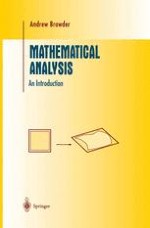1996 | OriginalPaper | Chapter
Sequences and Series
Author : Andrew Browder
Published in: Mathematical Analysis
Publisher: Springer New York
Included in: Professional Book Archive
Activate our intelligent search to find suitable subject content or patents.
Select sections of text to find matching patents with Artificial Intelligence. powered by
Select sections of text to find additional relevant content using AI-assisted search. powered by
In the first chapter, we defined a sequence in X to be a mapping from N to X. Let us broaden this definition slightly, and allow the mapping to have a domain of the form $$\left\{ {n \in {\rm Z}:m\underline < n\underline < p} \right\},or\left\{ {n \in {\rm Z}:n\underline > m} \right\}$$, for some m ∈ Z (usually, but not always, m = 0 or m = 1). The most common notation is to write n→ xn instead of n→ x(n). If the domain of the sequence is the finite set $$\left\{ {m,m + 1, \ldots ,p} \right\}$$, we write the sequence as $$\left( {x_n } \right)_{n = m}^p$$, and speak of a finite sequence (though we emphasize that the sequence should be distinguished from the set $$\left. {\left\{ {x_n :m\underline < n\underline < p} \right\}} \right)$$. If the domain of the sequence is a set of the form $$\left\{ {m,m + 1,m + 2, \ldots } \right\} = \left\{ {n \in {\rm Z}:n\underline { > m} } \right\}$$, we write it as $$(x_n )_{n = m}^\infty$$, and speak of an infinite sequence. Note that the corresponding set of values $$\left\{ {x_n :n\underline > m} \right\}$$ may be finite. When the domain of the sequence is understood from the context, or is not relevant to the discussion, we write simply (xn). In this chapter, we shall be concerned with infinite sequences in R.
